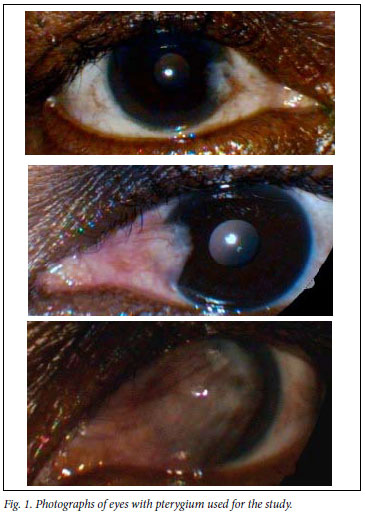Services on Demand
Article
Indicators
Related links
-
 Cited by Google
Cited by Google -
 Similars in Google
Similars in Google
Share
SAMJ: South African Medical Journal
On-line version ISSN 2078-5135
Print version ISSN 0256-9574
SAMJ, S. Afr. med. j. vol.101 n.2 Pretoria Feb. 2011
SCIENTIFIC LETTERS
Relationships of heredity and dry eye with pterygia in black African patients
Peter AnguriaI; Sam NtuliIII; Trevor CarmichaelII
IMB ChB, MMed Ophth Division of Ophthalmology, Department of Neurosciences, University of the Witwatersrand, Johannesburg
IIMB BCh, FCS (SA), PhD (Med), MSc (Med) Division of Ophthalmology, Department of Neurosciences, University of the Witwatersrand, Johannesburg
IIIBSc Stat, BSc (Hon) Stat, MSc Biostat University of Limpopo, Polokwane campus
To the Editor: Pterygium is a wing-shaped fibrovascular growth of the conjunctiva across the limbus onto the cornea.1 Although a hereditary influence on pterygium formation is recognised1 and a report of possible genetic influence in white South Africans has been published,2 little is known about these factors in black African populations.
Pterygia are widely believed to be due to excessive exposure to sunlight,3,4 and a long duration of ultraviolet radiation has been reported to be responsible for its development.5 The use of tobacco,6 a poor tear film,7 lower levels of education and skills,6 ethnicity,8 exposure to dust,8 malnutrition4 and chronic ocular surface inflammation8 have been reported or proposed as associations with pterygium occurrence. The relative importance of these factors has not been described in rural black Africans. This report is confined to investigating possible genetic factors and dry eye, which were the main associations found.
Ethical clearance was obtained from the institutional research ethics committees. We prospectively interviewed 71 patients and 71 age- and sex-matched controls in the Mankweng Eye Unit in Polokwane. Patients with ocular surface malignancy and pseudo-pterygium were excluded.
Consent was obtained and participants were shown three photographs of eyes with pterygia (Fig. 1) and asked questions similar to those used in a previous study.2 The patients were shown the photographs and asked if they had ever seen a person with such a growth on the eye. If they replied in the affirmative, they were asked if that person was a relative and if so what their relationship with the person was. Tear-film stability was assessed using a previously reported procedure;7 after application of 5% fluorescein, the cornea was assessed for areas of dark spots or streaks in between the blinks.

The mean age of the participants was 45 years (standard deviation 10.65), with a range of 22 - 65 years. There were nearly three times as many females as males in the series.
There was a positive family history of pterygium in 36% of cases and 10% of controls. A positive history was almost 5 times as common in cases as in controls. This was statistically significant (p<0.05, chi-square test).
The tear film was unstable in 7% of cases and 17% of controls. An unstable tear-film was 4 times more common in controls than in cases, and this was significant (p<0.05, chi-square test).
A positive family history implies hereditary predisposition.2 It was the only positive factor associated with the formation of pterygia in this study. In Australia 38% of patients admitted for pterygium surgery compared with 8 - 12% of controls admitted for other conditions had a family history of the growth.9 In South Africa 30 -35% of urban predominantly white individuals who had attended an ophthalmic practice because of pterygium had a positive family history.2
An unstable tear film (dry eye) was not associated with pterygium in this study, and this lack of association has previously been reported in Bantu patients.10 Pterygia may cause irritation with concomitant tearing that female patients have found problematic.11 The epiphora caused by ocular irritation may explain the finding of more dry eye in controls than cases. The association of dry eye with pterygium has been reported from Turkey7 and Nigeria,12 so the issue is unresolved.
The inherited predisposition that appears to underlie the formation of pterygium in black African patients requires further study.
References
1. Duke-Elder S. System of Ophthalmology. Vol 8, part 1. London: Kimpton, 1965: 573-582. [ Links ]
2. Carmichael TR. Genetic factors in pterygium in South Africans. S Afr Med J 2001;91:322. [ Links ]
3. Cameron ME. Pterygium throughout the world. Springfield: Thomas, 1965. [ Links ]
4. Moran DJ, Hollows FC. Pterygium and ultraviolet radiation: a positive correlation. Br J Ophthalmol 1984;68:343-346. [ Links ]
5. Mackenzie FD, Hirst LW, Battistutta D, Green A: Risk analysis in the development of pterygia. Ophthalmology 1992;99:1056-1061. [ Links ]
6. Wong TY, Foster PJ, Johnson GJ, Seah SKL, Tan DTH. The prevalence and risk factors for pterygium in an adult Chinese population in Singapore: the Tanjong Pagar survey. Am J Ophthalmol 2001; 31:176-183. [ Links ]
7. Kadayifcilar SC, Orhan M, Irkec M. Tear functions in patients with pterygium. Acta Ophthalmol. Scand 1998;76:176-179. [ Links ]
8. Hill JC, Maske R. Pathogenesis of pterygium. Eye 1989;3:218-226. [ Links ]
9. Booth F. Heredity in one hundred patients admitted for excision of pterygia. Aust NZ J Ophthalmol 1985;13:59-61. [ Links ]
10. Goldberg L, David R. Pterygium and its relationship to the dry eye in the Bantu. Br J Ophthalmol 1976;60:720-721. [ Links ]
11. Wilson G, Horner D, Begley C, Page J. Ocular discomfort from pterygium in men and women. Eye Contact Lens 2008;34:201-206. [ Links ]
12. Balogun MM, Ashaye AO, Ajayi BGK, Osuntokun OO. Tear break-up time in eyes with pterygia and pingueculae in Ibadan. W Afr J med 2005; 24: 162-166. [Pubmed] [ Links ]
Accepted 18 October 2010.
Corresponding author: P Anguria (irarak58@gmail.com)














